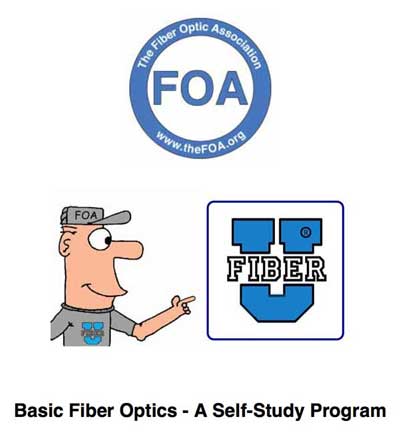Lesson #9, Fiber Optic Network Design
FOA Reference Guide To Fiber Optics
And Study Guide To FOA Certification

Answers To Chapter Questions
Chapter 9 Quiz -Design
TRUE/FALSE
1. ANS: T
The
fiber optic network designer must be familiar with electrical power
systems, since the electronic hardware must be provided with high
quality uninterruptible power at every location.
2. ANS: F
Before
one can begin to design a fiber optic cable plant, one needs to
establish with the end user or network owner where the network will be
built and what communications signals it will carry.
3. ANS: F
While
discussions of which is better – copper, fiber or wireless – has
enlivened cabling discussions for decades, it’s becoming moot.
Communications technology and the end user market, it seems, have
already made decisions that generally dictate the media and many
networks combine all three.
4. ANS: T
Most
projects start with the choice of a cable. Since OSP applications often
use significant lengths of cables, the cables can be made to order,
allowing optimization for that particular installation.
5. ANS: T
The
process of testing any fiber optic cable plant may require testing
three times, testing cable on the reel before installation, testing
each segment as it is installed and finally testing complete end to
end loss of every fiber in the cable plant.
MULTIPLE CHOICE
6. ANS: D
These are all important areas for the knowledgeable fiber optic network designer.
7. ANS: A
Any communications network must first be considered from the standpoint of the communications it should be transmitting.
8. ANS: D
Fiber optic network design involves all of the above and more!
9. ANS: D
Most
building management systems use proprietary copper cabling, for example
thermostat wiring and paging/audio speaker systems. Security monitoring
and entry systems, certainly the lower cost ones, still depend on
copper, although high security facilities like government and
military installations often pay the additional cost for fiber’s more
secure nature.
10. ANS: C
As
in OSP design, consider the fiber choice first. Most premises networks
use multimode fiber, but many users now install hybrid cables with
singlemode fibers for future expansion. The 62.5/125 micron fiber (OM1
fiber) that has been used for almost two decades has mostly been
superceded by the new 50/125 laser-optimized fiber (OM3), as it offers
substantial bandwidth/distance advantages.
11. ANS: B
Documentation
of the cable plant is a necessary part of the design and installation
process for a fiber optic network that is often overlooked.
12. ANS: D
Documentation is the most helpful thing you can have when trying to troubleshoot a fiber network, especially during restoration.
MULTIPLE RESPONSE
13. ANS: A, B, C, D
Metropolitan
networks owned and operated by cities can carry a variety of traffic,
including surveillance cameras, emergency services, educational
systems, telephone, LAN, security, traffic monitoring and control and
sometimes even traffic for commercial interests using leased bandwidth
on dark fibers or city-owned fibers.
Next: Lesson 10: Fiber Optic Network Installation
Return to Lesson Plan
|

